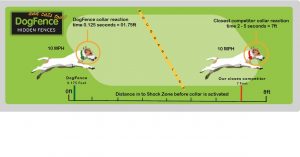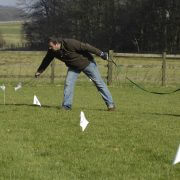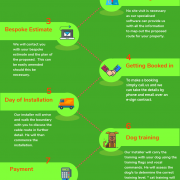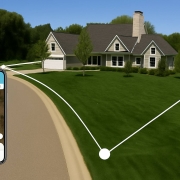Wireless and GPS Dog Fences vs Hidden Fences | DogFence UK
Is a GPS Dog Fence the Way Forward for Pet Containment?
A quick Google search brings up a myriad of choices for electronic dog fences. But is a GPS dog fence an easy and safe way to stop your dog escaping from the garden? The buzz word on the street maybe “GPS dog fence” and when it comes to keeping our pets safe, technology is continually offering innovative solutions. GPS dog fences are one such idea that seems promising at first glance. Using satellite tracking to create an invisible boundary for your pet sounds like the perfect combination of high-tech convenience and reliability. Easy and quick to install and relatively cheap compared to the more traditional dog fencing options. However, the truth is that GPS dog fences have significant limitations that make them far less effective than traditional pet containment systems. Let’s explore why GPS dog fences fall short and what alternatives might work better.
The Appeal of the GPS Dog Fence
One of the main attractions of GPS dog fences is their portability. Unlike physical or buried-wire fences, GPS boundaries can be set up anywhere there is satellite reception. This flexibility allows pet owners to create virtual fences around any space – whether at home, a campsite, or at a second home.
GPS dog fences can often allow for large boundary areas, and some models even come with smartphone apps to monitor your pet’s location in real-time (akin to the industry beating DogWatch Smart Fence System). The concept is undeniably appealing: a boundary-less containment solution with freedom for your dog to roam without the need for visible structures or a buried wire.
The Reality of GPS Dog Fences: Common Issues and Limitations
While the idea of a GPS dog fence is compelling, real-world usage has revealed significant limitations that can compromise both effectiveness and pet safety. Here are some of the most notable challenges:
- Inconsistent Boundaries
GPS dog fence signals are prone to interference from buildings, trees, and even weather conditions. This can cause the boundary to “drift,” meaning the actual area covered by the fence may shift unpredictably. For a dog, this can lead to confusion as the boundary changes location, sometimes making it impossible for the pet to know where the safe zone starts and ends. In areas where there is interference it may even create a “dead” zone which allows the dog to run out of the boundary.
- Speed – Delayed Responses
Unlike the top wired Systems (DogWatch, Invisible Fence) that react instantly, GPS dog fences can experience delays in signal transmission. If a dog crosses the boundary, it may take a few seconds for the collar to respond, which is enough time for the pet to run into danger. This delay reduces the overall reliability of the containment, especially in high-risk situations like close proximity to busy roads.
Currently DogWatch Hidden Fences offer the fastest reacting collars both on start up (dog running towards the fence) and shut down (dog stops and turns back). At less than 1 second, other brands can be 10 times slower and GPS fences slower still. The diagram below demonstrates the difference the time makes; which of course has a huge consideration for safety and welfare:

Collar reaction times for DogWatch Collars Supplied by DogFence UK
- Battery Limitations
GPS dog fences require power, usually from a battery in the dog’s collar. Battery life varies by model, but frequent charging is almost always required. For many pet owners, this is an inconvenience, but worse, a battery failure could result in your dog wandering off without any boundary protection. Again the current industry leader in terms of battery life is DogWatch, who offer a 2 year battery life on their standard weight collars (smaller and lighter than GPS collars) and a 6 month battery life on their mini collars (smallest lightest worldwide).
- Accuracy Concerns
Even with the best GPS technology, accuracy can vary. While some high-quality GPS devices are accurate within a few feet, cheaper models may only provide location accuracy within 15-25 feet or more. For boundary purposes, this inaccuracy can lead to unwanted breaches. In densely wooded or urban areas, accuracy issues become even more pronounced, making GPS systems unreliable. Similarly this is misleading to the pet and can cause confusion. Consistency is paramount in all aspects of dog training, and invisible dog fences are no exception. To ensure both safety and fairness, the boundaries and reinforcement need to be maintained continuously—every day, all year round.
- Limited Compatibility for Different Terrains and Properties
GPS dog fences struggle to function well in areas with dense foliage, hills, or other obstructions. If you live on a property with trees, hills, or a lot of other obstacles, a GPS fence is likely to have frequent errors. With a Professionally installed DogFence the wire any terrain can be catered for and the size of the property can be up to 350 acres. DogFence UK are the authorised installers for DogWatch Hidden Fences and have been professionally installing wired systems for over 20 years. At this point in time DogFence Ltd will not offer a GPS System as the safety and welfare of the dog would be comprised.
Comparing GPS Fences to Traditional Dog Containment Solutions
GPS dog fences may have some potential, but they fall short compared to traditional containment systems at this present time. Buried-wire electric fences provide consistent boundaries without the risk of signal interference, making them more reliable for most properties.
For dog owners who prioritize reliability and consistency, a physical or buried-wire electric fence is a more effective choice than GPS. Although GPS technology will continue to improve, for now, it cannot offer the security and dependability of a physical or buried boundary.
When (and If) GPS Fences Could Be Right for You
GPS dog fences may work for certain scenarios, such as large, open areas with minimal interference. For those who frequently travel with pets, the portability of a GPS dog fence can be an advantage. However, for day-to-day use around the home, especially in rural or hilly properties, a GPS dog fence is often impractical.
Frequently Asked Questions about GPS dog fences
Can a GPS dog fence work reliably in the UK?
No, the UK is country with a dense landscape — dense trees, buildings, and uneven terrain often interfere with GPS signals, causing drift of up to 1–3 m. This can lead to unpredictable corrections and safety risks. Hidden-wire systems offer stable, precise boundaries instead.
Are wireless dog fences suitable for small or irregularly-shaped gardens?
No. Wireless fences create fixed circular zones, which don’t suit narrow, irregular, or corner-heavy UK gardens (squares and rectangles). Signals can also become inconsistent near buildings and slopes.
Do GPS dog fence collars work for small dogs or cats?
Most GPS and wireless collars are heavy and bulky, making them unsuitable for smaller dogs and cats. Hidden-wire collars are lighter, more comfortable, and have better battery life.
Do GPS or wireless fences come with professional support and training?
Usually not. GPS and wireless systems are typically DIY with little to no professional support. Hidden-wire systems often include expert installation and tailored pet training.
Are wireless or GPS dog fences CE-approved and safe?
Many GPS and wireless fences lack CE approval and verified safety standards. Hidden-wire systems are usually CE-approved and comply with strict safety requirements.
Which is more accurate: GPS/wireless or hidden wire?
Hidden-wire systems provide exact, consistent boundaries with no drift, offering superior accuracy. GPS and wireless systems often have signal fluctuations and lower reliability.
Final Thoughts: Choosing the Best Solution for Your Pet’s Safety
While GPS dog fences sound appealing in theory, their limitations often make them impractical. For most dog owners, traditional pet containment systems provide a more reliable and safe solution. Whether you choose a physical fence, buried-wire, or wireless containment system, the key is ensuring that your pet remains safe and secure.
GPS technology is evolving, and perhaps in the future, GPS dog fences will become a viable alternative. Until then, tried-and-true containment systems offer the peace of mind that every pet owner needs.
By understanding the pros and cons of GPS dog fences, pet owners can make informed choices that best meet their pets’ needs and ensure their safety. While GPS containment might have potential, reliability and accuracy remain critical factors that other containment solutions handle better today.
If you would like to discuss the pros and cons of both GPS and Wired systems why not call us today for a chat. Our 20 + years experience in the field makes us the UK’s leading experts on pet containment solutions. Call today on 01628 476475 or email info@dogfence.co.uk.













